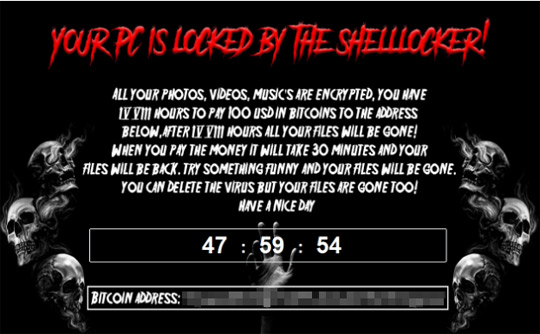RANSOM_EXOSHELL.A
Ransom_c.DHH (AVG), Trojan-Ransom.Win32.Gen.la (Kaspersky), Ransom.FileCryptor (Malwarebytes), Trojan:Win32/Dynamer!ac (Microsoft)
Windows


Threat Type: Trojan
Destructiveness: No
Encrypted: Yes
In the wild: Yes
OVERVIEW
This Trojan arrives as an attachment to email messages spammed by other malware/grayware or malicious users. It arrives on a system as a file dropped by other malware or as a file downloaded unknowingly by users when visiting malicious sites.
TECHNICAL DETAILS
Arrival Details
This Trojan arrives as an attachment to email messages spammed by other malware/grayware or malicious users.
It arrives on a system as a file dropped by other malware or as a file downloaded unknowingly by users when visiting malicious sites.
Autostart Technique
This Trojan drops the following file(s) in the Windows User Startup folder to enable its automatic execution at every system startup:
- %User Startup%\{random characters}.L0cked - multiple copies of itself
- %User Startup%\svchost.exe - copy of itself
(Note: %User Startup% is the current user's Startup folder, which is usually C:\Documents and Settings\{user}\Start Menu\Programs\Startup on Windows 2000 and XP, and C:\Documents and Settings\{User name}\Start Menu\Programs\Startup on Windows Vista, 7, and 8.)
Other Details
This Trojan encrypts files with the following extensions:
- .001
- .002
- .003
- .004
- .005
- .006
- .007
- .008
- .009
- .3dm
- .3g2
- .3gp
- .7z
- .8be
- .8bf
- .8bi
- .aaf
- .abr
- .accdb
- .adf
- .aep
- .aepx
- .aet
- .aex
- .ai
- .ai
- .aif
- .ani
- .apk
- .arw
- .as
- .as3
- .asd
- .asf
- .asp
- .asx
- .au
- .avi
- .bat
- .bay
- .bin
- .bmp
- .camproj
- .cdr
- .cer
- .class
- .cmd
- .com
- .CompositeFont
- .config
- .contact
- .contact
- .cpp
- .cr2
- .crdownload
- .crt
- .crw
- .cs
- .css
- .csv
- .cur
- .dat
- .db
- .dbf
- .dcr
- .der
- .dll
- .dng
- .doc
- .docb
- .docm
- .docx
- .dot
- .dotm
- .dotx
- .dwg
- .dxf
- .dxg
- .efx
- .eot
- .eps
- .erf
- .exe
- .fla
- .flv
- .fon
- .gif
- .hta
- .html
- .ico
- .idml
- .iff
- .indb
- .indd
- .indl
- .indt
- .ini
- .inx
- .ion
- .iso
- .jar
- .java
- .jnt
- .jnt
- .jpeg
- .jpg
- .json
- .k2p
- .kdc
- .key
- .lib
- .lng
- .lnk
- .load
- .m3u
- .m3u8
- .m4r
- .m4u
- .max
- .mdb
- .mdf
- .mef
- .mid
- .mkv
- .mov
- .mp3
- .mp4
- .mpa
- .mpeg
- .mpg
- .mrw
- .msg
- .msi
- .nef
- .nrw
- .odb
- .odc
- .odm
- .odp
- .ods
- .odt
- .orf
- .p12
- .p7b
- .p7c
- .pdb
- .pef
- .pem
- .pfx
- .php
- .pl
- .plb
- .pmd
- .png
- .pot
- .potm
- .potx
- .ppam
- .ppj
- .pps
- .ppsm
- .ppsx
- .ppt
- .ppt
- .pptm
- .pptx
- .prel
- .prproj
- .ps
- .psd
- .pst
- .ptx
- .r3d
- .ra
- .raf
- .rar
- .raw
- .rb
- .resx
- .rtf
- .rw2
- .rwl
- .scss
- .sdf
- .settings
- .SFX
- .sik
- .sldm
- .sldx
- .sln
- .sql
- .sr2
- .src
- .srf
- .srw
- .svg
- .swf
- .text
- .tgz
- .tif
- .ttc
- .ttf
- .txt
- .url
- .vb
- .vbproj
- .vbs
- .vbt
- .vcf
- .veg
- .vob
- .wav
- .wb2
- .wma
- .wmv
- .wpd
- .wps
- .x3f
- .xla
- .xlam
- .xlk
- .xll
- .xlm
- .xls
- .xls
- .xlsb
- .xlsm
- .xlsx
- .xlt
- .xltm
- .xltx
- .xlw
- .xml
- .xqx
- .zip
It renames encrypted files using the following names:
- {random characters}.L0cked
NOTES:
It encrypts files in the following locations:
- %Desktop%
- %User%\%MyMusic%
- %User%\%Documents%
- %User%\%MyVideos%
- %User%\%MyPictures%
It locks the screen and displays the following image which prevents users from accessing their systems or files:

SOLUTION
Step 1
Before doing any scans, Windows XP, Windows Vista, and Windows 7 users must disable System Restore to allow full scanning of their computers.
Step 2
Note that not all files, folders, and registry keys and entries are installed on your computer during this malware's/spyware's/grayware's execution. This may be due to incomplete installation or other operating system conditions. If you do not find the same files/folders/registry information, please proceed to the next step.
Step 3
Restart in Safe Mode
Step 4
Search and delete this file
- %User Startup%\svchost.exe
- %User Startup%\{random characters}.L0cked
Step 5
Restart in normal mode and scan your computer with your Trend Micro product for files detected as RANSOM_EXOSHELL.A. If the detected files have already been cleaned, deleted, or quarantined by your Trend Micro product, no further step is required. You may opt to simply delete the quarantined files. Please check this Knowledge Base page for more information.
Step 6
Restore encrypted files from backup.
Did this description help? Tell us how we did.

